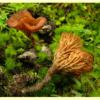
images/Arrhenia/Arrhenia_chlorocyanea_NE7202_GLay.jpg
Small agaric, mostly growing on the ground (often among bryophytes) or directly on bryophytes, or rarely on wood or litter, with a white spore print. Pileus pale, brown, grey or bluish. Lamellae subdecurrent or decurrent (reduced to shallow ridges in some foreign species). Stipe central, excentric or lateral. Veils absent. Spores hyaline, smooth, non-amyloid; germ pore absent. Cheilocystidia absent or rarely present. Lamellar trama regular or interwoven. Pileipellis a cutis; hyphae with encrusting pigment. Clamp connections present (absent in some foreign species).
The species of
Arrhenia with a central stipe and well-developed lamellae belong to a group of small agarics (pileus diameter less than 25 mm) with no partial veil and decurrent lamellae, formerly lumped together as
Omphalina (which, in the strict sense, does not occur in Australia). Among omphalinoid agarics
Lichenomphalia is very similar to lamellate
Arrhenia; however, all species of
Lichenomphalia lack clamp connections and are lichenised (growing on algal mats). Species of
Lichenomphalia are also commonly bright yellow or orange. The omphalinoid
Loreleia grows after fire (as can
Arrhenia), specifically among liverworts and mosses, but it has an orange pileus, and the lamellar trama is bidirectional.
Rickenella is omphalinoid and always grows among moss; it differs from
Arrhenia in the presence of well-developed caulocystidia, and it usually has a rather long stipe in relation to the pileus diameter. The common species (
R. fibula) is bright orange. Some drab species of
Mycena have decurrent lamellae, but they often occur on wood, and in addition the spores are usually amyloid and the pileipellis is either a cutis with nodulose hyphae or a hymeniderm.
Clitocybe is very similar to Arrhenia, but the fruit-body is larger (usually more than 25 mm diameter).
Species of Arrhenia with lateral stipes are distinguished from other small laterally stiped agarics with a white spore print (such as Panellus stipticus or Resupinatus) by nearly always growing on the ground or mosses (rather than on wood), the drab colours, non-viscid pileus, non-amyloid spores and a pileipellis of smooth (not nodulose) hyphae. Among laterally-stiped agarics growing on the ground, or around rotting wood, Hohenbuehlia and Panellus ligulatus have gloeosphex cystidia and the former also has metuloid cystidia, and Gymnopus has cheilocystidia.
Arrhenia Fr., Summa Veg. Scand. 312 (1849).
A few species:
Arrhenia australis and
A. aff.
chlorocyanea, but possibly more.
Many species now in Arrhenia were previously placed in Omphalina, which is now restricted to O. pyxidata and a few other species. Omphalina in the strict sense is not confirmed as occurring in Australia.
W.A., S.A., N.S.W., Vic. and Tas. (and probably also N.T. and Qld).
In native forests. Sometimes along track sides or after fire.
On the ground, often among bryophytes. Rarely on wood or litter (but not obviously decaying the wood).
Saprotrophic, some parasitic on bryophytes.
Breitenbach, J. & Kränzlin, F. (eds) (1991),
Fungi of Switzerland.
Volume 3. Boletes and Agarics 1st part. Edition Mykologia, Lucerne. [
Illustration,
Description and
Microcharacters of 11 species of
Arrhenia from Europe, with seven species treated under
Omphalina (
A. epichysium,
A. griseopallida,
A. obatra,
A. onisca,
A. rickenii,
A. sphagnicola and
A. velutipes)]
Grgurinovic, C.A. (1997a), Larger Fungi of South Australia. The Botanic Gardens of Adelaide and State Herbarium and The Flora and Fauna of South Australia Handbooks Committee, Adelaide. [Description and Microcharacters of A. australis]
Redhead, S.A. (1984), Arrhenia and Rimbachia, expanded generic concepts, and a reevaluation of Leptoglossum with emphasis on muscicolous North American taxa, Canad. J. Bot. 62: 865–892. [Description, Microcharacters and Key for seven non-Australian species of Arrhenia, mostly those with reduced or absent lamellae, and B&W Illustration of A. lobata]



